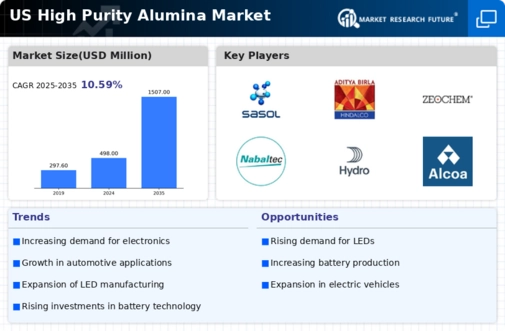The high purity alumina market is characterized by a dynamic competitive landscape, driven by increasing demand from sectors such as electronics, automotive, and renewable energy. Key players are actively pursuing strategies that emphasize innovation, regional expansion, and sustainability. For instance, Alcoa Corporation (US) has focused on enhancing its production capabilities through technological advancements, while Alumina Limited (AU) has been exploring strategic partnerships to bolster its market presence. These strategies collectively contribute to a competitive environment that is increasingly shaped by the need for high-quality products and efficient supply chains.
In terms of business tactics, companies are localizing manufacturing to reduce lead times and optimize supply chains. The market structure appears moderately fragmented, with several players vying for market share. This fragmentation allows for a diverse range of offerings, yet the influence of key players remains significant, as they set benchmarks for quality and innovation that others strive to meet.
In November 2025, Nabaltec AG (DE) announced the launch of a new high purity alumina product line aimed at the semiconductor industry. This strategic move is likely to enhance their competitive positioning by catering to the growing demand for advanced materials in electronics, thereby aligning with industry trends towards miniaturization and efficiency. The introduction of this product line may also facilitate Nabaltec AG's entry into new markets, further diversifying its revenue streams.
In October 2025, Sibelco (BE) expanded its production capacity in the US by investing in a new facility dedicated to high purity alumina. This expansion is indicative of Sibelco's commitment to meeting the rising demand in North America, particularly from the lithium-ion battery sector. By increasing its production capabilities, Sibelco positions itself to capitalize on the anticipated growth in electric vehicle manufacturing, which is expected to drive demand for high purity alumina.
In September 2025, Sierra Aluminum Company (US) entered into a strategic alliance with a leading technology firm to integrate AI-driven solutions into its production processes. This partnership is expected to enhance operational efficiency and product quality, reflecting a broader trend within the industry towards digital transformation. By leveraging AI, Sierra Aluminum Company aims to optimize its supply chain and reduce production costs, thereby improving its competitive edge.
As of December 2025, the competitive trends in the high purity alumina market are increasingly defined by digitalization, sustainability, and technological integration. Strategic alliances are becoming more prevalent, as companies recognize the need to collaborate in order to innovate and meet evolving customer demands. Looking ahead, it appears that competitive differentiation will shift from traditional price-based competition to a focus on innovation, technology, and supply chain reliability, as companies strive to deliver superior products and services in a rapidly changing market.

















Leave a Comment